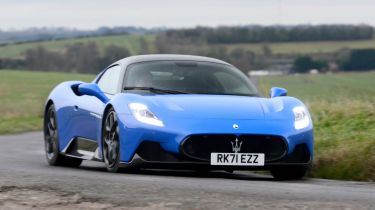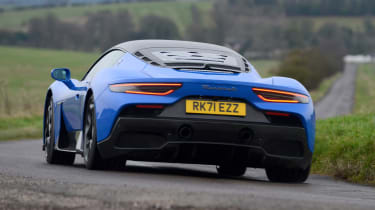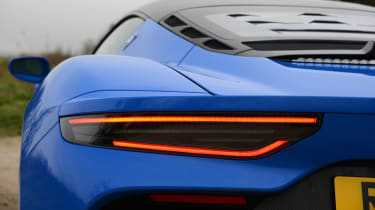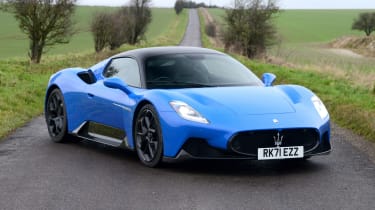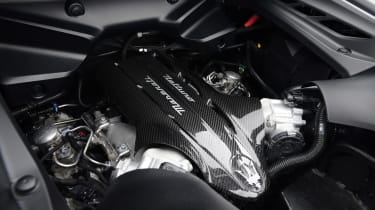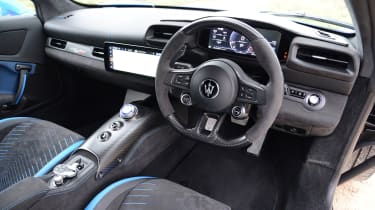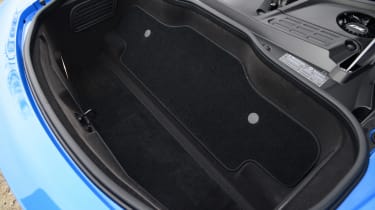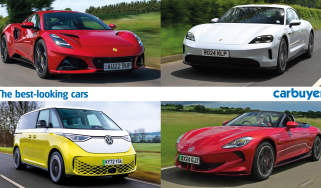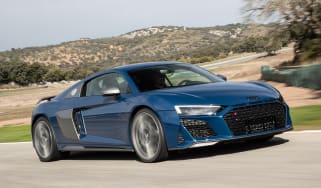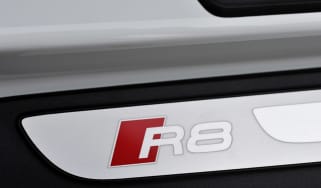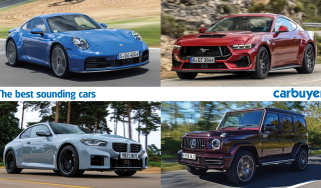Maserati MC20 coupe review
“Maserati returns to the supercar scene with the highly impressive MC20”
Pros
- Agile and fast
- Attention-grabbing looks
- Comfortable
Cons
- Other supercars sound better
- Small fuel tank
- Costly options
Maserati’s recent line-up has focused on the flamboyant but flawed Ghibli and Quattroporte executive saloons, plus the Porsche Cayenne-rivalling Levante SUV. So it's about time the Italian brand got back to its roots and introduced another supercar, especially as replacement for the discontinued Maserati GranTurismo coupe is still some way off.
It’s actually nearly 20 years since Maserati’s last supercar hit the road. That was the outlandish MC12, with a rear wing wider than the rest of the bodywork, a roof-mounted air vent and mechanicals and suspension from the iconic Enzo from sister brand Ferrari.
Supercar enthusiasts are likely to spot styling details in the Maserati MC20 that hark back to the MC12, but you won’t need to be a petrolhead to notice when the eye-catching and exotic MC20 rumbles by. Its low nose and the air vents in the rear screen in the shape of Maserati’s famous trident badge give the car real presence, while upwards-opening butterfly doors are likely to draw a crowd when the car comes to a stop.
It’d be easy to create a car that looked great and was only designed to show off around city streets, but the MC20 has a far broader array of talents. On the move it feels compact, precise and delicate (but not fragile), and is very easy to drive fast. The steering is beautifully judged, and in the car’s most laid-back settings you could even describe it as comfortable.
Powering the MC20 is a 3.0-litre V6 petrol engine with two turbochargers. Developed by Maserati itself (the brand has often had help from Ferrari), the engine is claimed to use the firm’s Formula 1 know-how to boost power. The result is 621bhp near the top of the 8,000rpm redline, and a 0-62mph time of under three seconds.
Turbocharged engines often have a muted soundtrack compared to naturally aspirated ones, and the same is true here; the MC20 doesn’t sound quite as enthralling as the traditional naturally aspirated units in the Lamborghini Huracan or the Porsche 911 GT3.
The noise is almost understated from the inside (besides the snarl on start-up), and the interior doesn’t quite have the flair of the exterior. Lashings of genuine carbon fibre, a focused digital dial cluster and buttons hanging from the steering wheel give it a real sporty feel, though, and the technology on board stops it feeling like a stripped-out motorsport special only suitable for the race track. There are frustrations, however, such as the infotainment screen, which has been placed so low on the dashboard that it’s difficult to use it without taking your eyes off the road for lengthy periods.
In the future, the MC20 will gain convertible and fully electric variants. These have been in the planning right from the development stage, so only minor tweaks will be needed to the car’s structure and underpinnings.
MPG, running costs & CO2
You’re probably not that interested in the price of fuel if you have the means to buy a Maserati MC20, so we’ll just quickly mention that it claims up to 24.4mpg and emits 262g/km of CO2. It sits in the higher echelons for road tax and business tax, and will require deep pockets when it’s time for a service. Replacing the wide, low-profile tyres will remind you that the MC20 is a supercar, too - although the standard carbon ceramic brakes should last a lot longer than conventional cast iron discs.
The 60-litre fuel tank is a little small for a car like this, so you’ll be spending a fair amount of time filling up. At least it’ll give you a chance to experience all those admiring glances.
Engines, drive & performance
The MC20’s exotic specification means there are no doubts about its supercar credentials. It’s underpinned by a carbon-fibre chassis that’s been developed in partnership with legendary Italian racing car constructor Dallara, while some of the suspension componentry used is usually reserved for purebred racing cars.
Underneath that distinctive rear windscreen with its Maserati trident-shaped air vents is a 3.0-litre V6 petrol engine with two turbochargers. While previous Maserati models have used a Ferrari-derived engine, the ‘Nettuno’ unit used in the MC20 was designed in-house and features Formula 1 tech, such as twin-spark plugs and both direct and indirect fuel injection.
Although the Maserati’s 621bhp power output looks good in isolation, it’s actually a little mild compared to some of today’s supercars and hypercars. However, the MC20 offsets any disadvantage with its relatively low kerbweight.
For instance, the car’s carbon-fibre monocoque chassis alone weighs just 100kg, helping the whole car to tip the scales at just under 1,500kg. As a result, the MC20 hits 0-62mph in just 2.9 seconds (the same as a Ferrari 296 GTB or McLaren 720S) and will carry on accelerating until it hits its 202mph top speed.
Yet despite these startling performance figures, the Maserati is actually very user-friendly to drive. Yes it’ll wheelspin on damp roads through several of the gears if you turn the traction and stability control systems off, but the rest of the time it feels surprisingly easy to drive.
The steering is fast and well-weighted, allowing you to place the car accurately and confidently on the road. In fact, with its compact dimensions and lightweight build, the MC20 has a similar agile and focused feel to smaller sports cars, such as the Porsche 911 or Alpine A110, rather than the sometimes intimidating driving experience you would expect from a thoroughbred supercar with a six-figure price tag.
Like most high performance cars on sale today there’s no manual gearbox option, but the good news is that the Maserati’s eight-speed dual-clutch automatic is well-suited to the MC20. It changes gear quickly and smoothly, while the rev-matching function blips the throttle on down changes for that authentic sports car sound and feel.
If there’s a disappointment with the Maserati, then it’s the rather subdued noises from the V6 powerplant. The engine bursts into life with a suitably racy flare of noise, but when you work it hard the unit lacks the spine-tingling bellow of the brand’s old V8 engines. If you want an authentic supercar soundtrack, then Lamborghini Huracan’s howling naturally aspirated V10 is a better bet.
Interior & comfort
In the past, supercars were tricky to drive everyday. With heavy controls and poor visibility they weren’t well suited to trips into town or slotting into a supermarket car park. However, these days this type of car is much more user-friendly - and the MC2 is no exception. Forward visibility is pretty good in the Maserati MC20, plus there’s a neat digital rear-view mirror that uses a camera on the back of the car to help you see what’s behind you.
Elsewhere, the MC20 looks and feels like a true supercar. You sit low down in extremely supportive racing-style seats, while ahead of is a configurable digital instrument pack and thick-rimmed steering wheel with numerous controls on its spokes. The dashboard and seats are covered in leather, while everything else seems to be finished in either carbon fibre (real, of course) or Alcantara suede.
A touchscreen takes care of navigation and infotainment functions, while the dial below it allows you to switch between GT, Sport, Corsa and Wet driving modes. However, the screen is mounted low down on the dashboard, making it hard to read or use without taking your eyes off the road for longer than is comfortable.
While the MC20 has a reasonable spread of standard equipment, you can add plenty of options. That the configurator doesn’t feature prices is a sign that ticking a few boxes will dramatically increase the price; and that if you have to ask, then you probably can’t afford it!
For example, the two-tone colour scheme of the car pictured here costs around £8,000, while the nose lifter is a little over £3,000 (but worthwhile, as it helps avoid grazing the expensive carbon fibre bodywork on low kerbs) and the carbon-fibre exterior pack is a touch over £34,000. When added up, the options on our car totalled an eye-watering £65,000.
Practicality & boot space
Just like all its main rivals, the MC20 is a strict two-seater. Most drivers should be able to get comfy inside, although taller people may find their head brushing the headlining - especially on track days where you’ll need to wear a crash helmet.
You’ll also need to pack light if you want to use your MC20 for a weekend away. Opening the boot lid reveals a rather miserly 100-litre storage space, which is further compromised by its odd shape. There’s also a storage area under the bonnet complete with a net to keep small things in place, but at 50 litres it's barely big enough for the smallest soft bag.
We recognise that practicality won’t be top priority for MC20 buyers, but something like a McLaren GT is able to carry longer and larger items like golf clubs.
Reliability & safety
The carbon-fibre core of the MC20 is designed to keep a driver safe in the event of a high-speed crash while on a racing track, so it’ll also protect you in a collision at road speeds. Carbon ceramic brakes should ensure you can stop on a sixpence if something happens in front of you. The options list also includes various active driver safety aids, such as blind-spot monitoring and rear cross-traffic alert.
Reliability is less easy to predict, because dramatic Italian supercars aren’t traditionally known for their bulletproof reliability. However, any Maserati owner is likely to use their car sparingly and keep on top of maintenance, so durability shouldn’t be an issue. The standard trickle charger will also help keep the battery in top condition when you’re not using the car.
Which Is Best?
Cheapest
- NameV6 2dr Auto
- Gearbox typeSemi-auto
- RRP£225,610
Most Economical
- NameV6 2dr Auto
- Gearbox typeSemi-auto
- RRP£225,610
Fastest
- NameV6 2dr Auto
- Gearbox typeSemi-auto
- RRP£225,610

